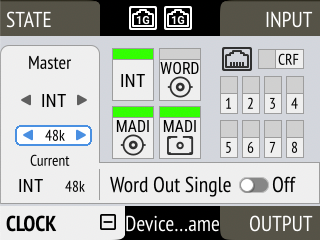Sample Rates Overview
The M-32 AD Pro II supports the following sample rates:
Single speed |
44.1 kHz, 48 kHz |
Double speed |
88.2 kHz, 96 kHz |
Quad speed |
176.4 kHz, 192 kHz |
If the device is clock reference ("leader"/"master"), these rates always correspond to the actual sample rate used.
Following an External Clock Reference
When the device is synchronized to an external clock reference ("follower"/"slave"), certain deviations are automatically accepted to avoid interruption of the outgoing audio signal when the sample rate changes. This is called Intelligent Clock Control (ICC). It also handles deriving a sample rate of double or quad speed based on an incoming rate.
Input |
Clock at input |
Selected Sample Rate |
Resulting Sample Rate |
MADI |
44.1 |
44.1 |
44.1 |
MADI |
44.1 |
48 |
44.1 with warning |
MADI |
44.1 |
88.2 |
88.2 |
MADI |
44.1 |
96 |
88.2 with warning |
MADI |
44.1 |
176.4 |
176.4 |
MADI |
44.1 |
192 |
176.4 with warning |
MADI |
48 |
44.1 |
48 with warning |
MADI |
48 |
48 |
48 |
MADI |
48 |
88.2 |
96 with warning |
MADI |
48 |
96 |
96 |
MADI |
48 |
176.4 |
192 with warning |
MADI |
48 |
192 |
192 |
MADI 96k |
88.2 |
44.1 |
warning (no sync) |
MADI 96k |
88.2 |
48 |
warning (no sync) |
MADI 96k |
88.2 |
88.2 |
88.2 |
MADI 96k |
88.2 |
96 |
88.2 with warning |
MADI 96k |
88.2 |
176.4 |
warning (no sync) |
MADI 96k |
88.2 |
192 |
warning (no sync) |
MADI 96k |
96 |
44.1 |
warning (no sync) |
MADI 96k |
96 |
48 |
warning (no sync) |
MADI 96k |
96 |
88.2 |
96 with warning |
MADI 96k |
96 |
96 |
96 |
MADI 96k |
96 |
176.4 |
warning (no sync) |
MADI 96k |
96 |
192 |
warning (no sync) |
Word Clock |
44.1 |
44.1 |
44.1 |
Word Clock |
44.1 |
48 |
44.1 (with warning) |
Word Clock |
44.1, 88.2 |
88.2 |
88.2 |
Word Clock |
44.1, 88.2 |
96 |
88.2 with warning |
Word Clock |
44.1, 88.2, 176.4 |
176.4 |
176.4 |
Word Clock |
44.1, 88.2, 176.4 |
192 |
176.4 with warning |
Word Clock |
48 |
44.1 |
48 with warning |
Word Clock |
48 |
48 |
48 |
Word Clock |
48, 96 |
88.2 |
96 with warning |
Word Clock |
48, 96 |
96 |
96 |
Word Clock |
48, 96, 192 |
176.4 |
192 with warning |
Word Clock |
48, 96, 192 |
192 |
192 |
There is no ICC mechanism necessary for AVB; the device will always use the exact clock from the corresponding AVB stream.
| It is not recommended to synchronize devices with a higher sample rate than the current sample rate, because two devices could choose different edges of the incoming clock signal. |
| ICC does not affect outgoing AVB streams. Outgoing AVB streams will always correspond to the sample rate set in the CLOCK section. If the reference clock changes its frequency, outgoing AVB streams will be interrupted. |
Number of Channels
The supported number of channels per port or stream at different sample rates is shown in the following table.
44.1 kHz |
48 kHz |
88.2 kHz |
96 kHz |
176.4 kHz |
192 kHz |
|
MADI 56 Ch |
56 |
56 |
28 |
28 |
14 |
14 |
MADI 64 Ch |
64 |
64 |
32 |
32 |
16 |
16 |
MADI 56 Ch + 96k |
--- |
--- |
28 |
28 |
--- |
--- |
MADI 64 Ch + 96k |
--- |
--- |
32 |
32 |
--- |
--- |
AVB 1-8 Ch stream |
1-8 |
1-8 |
1-8 |
1-8 |
1-8 |
1-8 |
AVB 12 Ch stream |
12 |
12 |
12 |
12 |
--- |
--- |
AVB 16 Ch stream |
16 |
16 |
--- |
--- |
--- |
--- |
| Since there are two independent MADI ports, the total supported number of channels can be multiplied by two. Since there are eight independent AVB streams, the total supported number of channels can be multiplied by eight. The analog channel count remains identical at all sample rates. |
Selecting a Sample Rate
-
Enter the CLOCK section.

-
Rotate the encoder to highlight the current sample rate.
-
Push the encoder. Two blue arrows will appear to indicate that the encoder can now be used to change the current setting.
-
Rotate the encoder until the preferred sample rate is shown.
-
Push the encoder again to activate the setting.
Effects of Sample Rate Changes on Existing Routing
The M-32 AD Pro II saves one routing table per preset, regardless of sample rate. A change of sample rate or MADI frame mode can reduce the number of input and output channels available for routing. This does not alter the routing table. Any existing routing is hidden until another change of sample rate re-enables the channels.
A routing is created at 96 kHz with 32 channels, sending the MADI coaxial Input 1-32 to optical MADI Output 1-32. If the sample rate is now changed to 176.4 kHz and the 56 Ch frame is activated, only the first 14 channels of MADI coaxial input are routed to the optical output. Switching the sample rate to 44.1 or 48 kHz will reveal the previous routing for 32 channels.